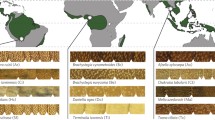Abstract
To elucidate how enriched CO2 atmospheres, soil fertility, and light availability interact to influence the long-term growth of tree seedlings, six co-occurring members of temperate forest communities including ash (Fraxinus americana L.), gray birch (Betula populifolia), red maple (Acer rubrum), yellow birch (Betula alleghaniensis), striped maple (Acer pensylvanicum), and red oak (Quercus rubra L.) were raised in a glasshouse for three years in a complete factorial design. After three years of growth, plants growing in elevated CO2 atmospheres were generally larger than those in ambient CO2 atmospheres, however, magnitudes of CO2-induced growth enhancements were contingent on the availability of nitrogen and light, as well as species identity. For all species, magnitudes of CO2-induced growth enhancements after one year of growth were greater than after three years of growth, though species' growth enhancements over the three years declined at different rates. These results suggest that CO2-induced enhancements in forest productivity may not be sustained for long periods of time. Additionally, species' differential growth responses to elevated CO2 may indirectly influence forest productivity via long-term species compositional changes in forests.
Similar content being viewed by others
References
Arp WJ (1991) Effects of source-sink relations on photosynthetic acclimation to elevated CO2. Plant Cell Env 14:869–875
Bazzaz FA (1990) The response of natural ecosystems to the rising global CO2 levels. Ann Rev Ecol Syst 21:167–196
Bazzaz FA, Miao SL (1993) Successional status, seed size and response of tree seedlings to CO2, light, and nutrients. Ecology 74:104–112
Bazzaz FA, Coleman JS, Morse SR (1990) Growth responses of seven major co-occurring tree species of the northeastern United States to elevated CO2. Can J For Res 20:1479–1484
Bowes G (1991) Growth at elevated CO2: photosynthetic responses mediated through Rubisco. Plant Cell Envt 14:795–806
Burns RM, Honkala BH (1990) Silvics of North American Trees. Vol 2, Hardwoods. U.S. Dept of Agriculture, Washington D.C.
Conroy JP, Barlow EWR, Bevege DI (1986) Response of Pinus radiata seedlings to carbon dioxide enrichment at different levels of water and phosphorus: growth, morphology and anatomy. Ann Bot 57:165–177
Curtis PS, Drake BG, Leadley PW, Arp WJ, Whigham DF (1989) Growth and senescence in plant communities exposed to elevated CO2 concentrations on an estuarine marsh. Oecologia 78:20–26
Delucia EH, Sasek TW, Strain BR (1985) Photosynthetic inhibition after long-term exposure to elevated levels of atmospheric carbon dioxide. Photosyn Res 7:175–184
Eamus D, Jarvis PG (1989) The direct effects of increase in the global atmospheric CO2 concentration on natural and commercial temperature trees and forests. Adv Ecol Res 19:1–53
Evans GC (1972) The Quantitative Analysis of Plant Growth. Blackwell, Oxford
Farrar JF, Williams ML (1991) The effects of increased atmospheric carbon dioxide and temperature on carbon partitioning, source-sink relations and respiration. Plant Cell Env 14:819–830
Houghton JT (1991) The role of forests in affecting the greenhouse gas composition of the atmosphere. In: Wymann RL (ed) Global Climate Change and Life on Earth. Chapman and Hall, New York, pp 43–56
Herold A (1980) Regulation of photosynthesis by sink activity —the missing link. New Phytol 86:131–144
Hunt R, Hand DW, Hannah MA, Neal AM (1991) Response to CO2 enrichment in 27 herbaceous species. Funct Ecol 5:410–421
Idso SB, Kimball BA (1992) Effects of atmospheric CO2 enrichment on photosynthesis, respiration, and growth of four sour orange trees. Plant Physiol 99:341–343
Idso SB (1991) Comment on “Modeling the seasonal contribution of a CO2 fertilization effect of the terrestrial vegetation to the amplitude increases in atmospheric CO2 at Mauna Loa Observatory” by G. H. Kohlmaier et al. Tellus 43B:338–34
Kauppi PE, Mielikainen K, Kullervo K (1992) Biomass and carbon budget of European forests, 1971 to 1990. Science 256:70–74
Kohlmaier GH, Sire E, Janecek A, Keeling CD, Piper SC, Revelle R (1989) Modeling the seasonal contribution of a CO2 fertilization effect of the terrestrial vegetation to the amplitude increases in atmospheric CO2 at Mauna Loa Observatory. Tellus 41B:487–510
McConnaughay KDM, Berntson GM, Bazzaz FA (1993) Limitations to CO2-induced growth enhancement in pot studies. Oecologia 94:550–557
Miao SL, Wayne PM, Bazzaz FA (1992) Elevated CO2 differentially alters the responses of co-occurring birch and maple seedlings to a moisture gradient. Oecologia 90:300–304
Norby RJ, Gunderson CA, Wullschleger SD, O'Neill EG, McCraken MK (1992) Productivity and compensatory responses of yellow-poplar trees in elevated CO2-Nature 357:322–323
Pettersson R, MacDonald JS (1992) Effects of elevated carbon dioxide concentrations on photosynthesis and growth of small birch plants (Betula pendula Roth.) at optimal nutrition. Plant Cell Envt 15:911–919
Rochefort L, Bazzaz FA (1992) Grow response to elevated CO2 in seedlings of four co-occurring birch species. Can J For Res 22:1583–1587
Sage RF, Sharkey TD, Seemann JR (1989) Acclimation of photosynthesis to elevated CO2 in five C3 species. Plant Physiol 89:590–596
Sokal RR, Rohlf FJ (1981) Biometry. Freeman and Company, New York
Thomas RB, Strain BR (1991) Root restriction as a factor in photosynthetic acclimation of cotton seedlings grown in elevated carbon dioxide. Plant Physiol 96:627–634
Tolley LC, Strain BR (1985) Effects of CO2 enrichment and water stress on gas exchange of Liquidambar styraciflua and Pinus taeda seedlings grown under different irradiance levels. Oecologia 65:166–172
Williams WE, Garbutt K, Bazzaz FA, Vitousek PM (1986) The response of plants to elevated CO2 IV. Two deciduous-forest tree communities. Oecologia 69:454–459
Author information
Authors and Affiliations
Rights and permissions
About this article
Cite this article
Bazzaz, F.A., Miao, S.L. & Wayne, P.M. CO2-induced growth enhancements of co-occurring tree species decline at different rates. Oecologia 96, 478–482 (1993). https://doi.org/10.1007/BF00320504
Received:
Accepted:
Issue Date:
DOI: https://doi.org/10.1007/BF00320504




